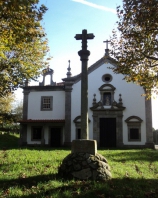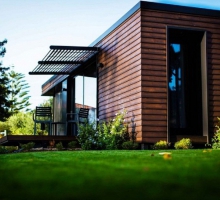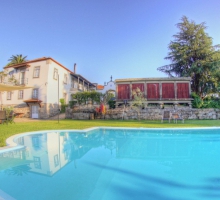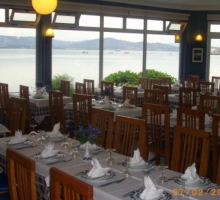The new church, located at the foot of Crastros`Hill, in Vilar de Mouros, it was settled in 1713, by the reverend Domingos Pereira Barreto. All the sculpture theme is concentrated in the suffering of Christ.
“The longitudinal plan composed by unequal and articulated volumes horizontally articulated, the nave and the main chapel are tall, high and rectangular, and sacristy and storage room, this last one with two floors, also rectangular, addorsed at East, significantly retreated to the front. Articulated volumes with different coverings with gable roofs in the nave, main chapel and sacristy, and hip and valley roofs in the storage room. The border facing north has a salient basement and ends in gable. The axial portal with a straight lintel, framed by pilasters supporting fins gable interrupted by rectangular window, topped by a curved pediment, sheltering the image of the Lady of the Assumption, and laterally topped by curved pediments; on the top a spy-glass. In the portal frieze there is a memorial panel with the date 1739. Flanking the gate two rectangular windows topped with curved pediment, side walls and rear facades with framed cornices, cornerstones with Tuscan pilasters topped by pinnacles. Crowning the gables the Latin cross on plinth. On the West façade it opens a door and a high window with rectangular window opening and, in the main chapel, identical window.
On the East facade there are rectangular windows opening. Inside, nave and chancel canonicals with wainscot tile, being towed in the remaining area. High-chorus with a balustrade, over columns of Tuscan chapiter, over parallelepiped plinth, with side access through the upper floor of the storage room. On the side of the Gospel, there`s a stony base framed, based on a spiral and balustrade console. Full triumphal arch flanked by two altarpieces of painted carving posted in angles. Wood ceilings in a trough shape. The high altar has a painted alter piece, displaying the three crosses of Christ crucified, flanked by two thieves. Ceiling in a barrel-vault build.
Location: Caminha
“The longitudinal plan composed by unequal and articulated volumes horizontally articulated, the nave and the main chapel are tall, high and rectangular, and sacristy and storage room, this last one with two floors, also rectangular, addorsed at East, significantly retreated to the front. Articulated volumes with different coverings with gable roofs in the nave, main chapel and sacristy, and hip and valley roofs in the storage room. The border facing north has a salient basement and ends in gable. The axial portal with a straight lintel, framed by pilasters supporting fins gable interrupted by rectangular window, topped by a curved pediment, sheltering the image of the Lady of the Assumption, and laterally topped by curved pediments; on the top a spy-glass. In the portal frieze there is a memorial panel with the date 1739. Flanking the gate two rectangular windows topped with curved pediment, side walls and rear facades with framed cornices, cornerstones with Tuscan pilasters topped by pinnacles. Crowning the gables the Latin cross on plinth. On the West façade it opens a door and a high window with rectangular window opening and, in the main chapel, identical window.
On the East facade there are rectangular windows opening. Inside, nave and chancel canonicals with wainscot tile, being towed in the remaining area. High-chorus with a balustrade, over columns of Tuscan chapiter, over parallelepiped plinth, with side access through the upper floor of the storage room. On the side of the Gospel, there`s a stony base framed, based on a spiral and balustrade console. Full triumphal arch flanked by two altarpieces of painted carving posted in angles. Wood ceilings in a trough shape. The high altar has a painted alter piece, displaying the three crosses of Christ crucified, flanked by two thieves. Ceiling in a barrel-vault build.
Location: Caminha






